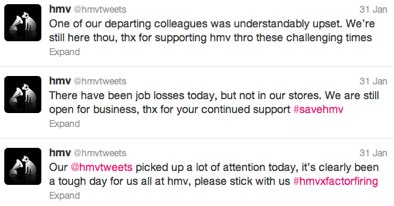“We’re tweeting live from HR where we’re all being fired! Exciting!! #hmvXFactorFiring”
If you’re going to fire your social media planner wouldn’t you think to change the passwords first? This week British retailer HMV’s slight oversight, led to a live broadcast of their 60 person mass layoff to their official twitter account’s 60,000 + followers.
So who are HMV and what happened?
HMV is a 91-year-old British entertainment retailer similar to the almost defunct Virgin Megastore. I have always been a huge music fan and in my teens this was one of my favorite stores. As you can imagine given the online shift HMV has struggled to adapt its business model fast enough to the changed business environment.
On January 15, 2013 HMV entered administration (a form of bankruptcy).
On January 31, 2013 following advice from Deloitte, HMV laid off 190 employees from their corporate office and distribution centers. While this was always going to be a difficult task, the situation gained more exposure than HMV could ever have imagined, as their about to be laid off social media planner Poppy Rose Cleere tweeted the events live from the company’s twitter account:
Comparing the corporate office mass firing of 60 employees to an X Factor elimination the hashtag #hmvXFactorFiring quickly went viral as HMV gained over 10,000 new Twitter followers.
The remaining employee’s lack of ability with social media was laid out for the world to see as these tweets reveal:
The tweets were later taken down but the damage had been done and they are now part of the company’s digital footprint. Poppy Rose Cleere who had been responsible for managing HMV’s social media accounts for over 2 years, explained her action as the result of frustration at seeing the company she loved ruined. She hopes her actions can help educate HMV remaining executives finally realize the importance of social media:
HMV has responded by sending out the following tweets:
Time will tell if their remaining marketing staff choose to utilize social media as a way to engage with their customers. For now HMV needs to find a way to create customer experiences to stop the brand from heading to “Borders” town.
What’s your take on this story? Share your thoughts in the comments section below.














